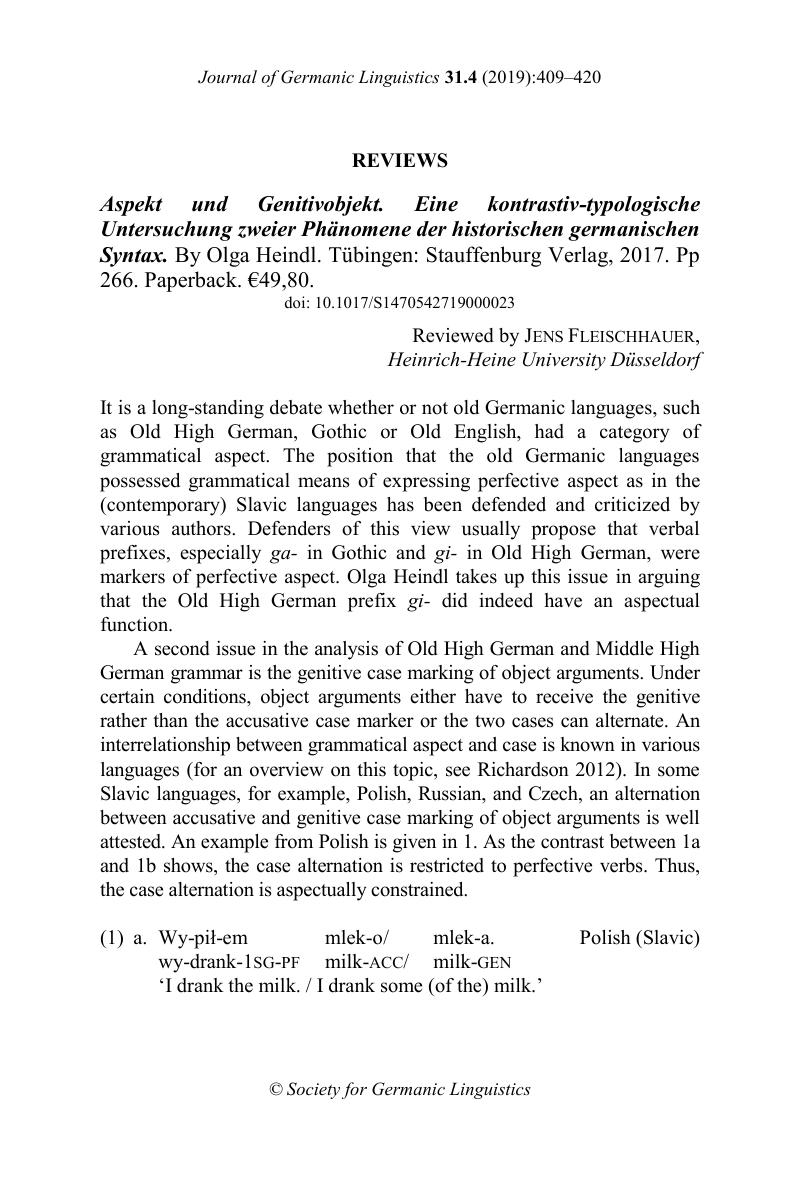No CrossRef data available.
Article contents
Aspekt und Genitivobjekt. Eine kontrastiv-typologische Untersuchung zweier Phänomene der historischen germanischen Syntax. By Olga Heindl. Tübingen: Stauffenburg Verlag, 2017. Pp 266. Paperback. €49,80.
Review products
Aspekt und Genitivobjekt. Eine kontrastiv-typologische Untersuchung zweier Phänomene der historischen germanischen Syntax. By Olga Heindl. Tübingen: Stauffenburg Verlag, 2017. Pp 266. Paperback. €49,80.
Published online by Cambridge University Press: 06 November 2019
Abstract
An abstract is not available for this content so a preview has been provided. Please use the Get access link above for information on how to access this content.

- Type
- Reviews
- Information
- Copyright
- © Society for Germanic Linguistics 2019
References
Borik, Olga. 2006. Aspect and reference time. Oxford: Oxford University Press.CrossRefGoogle Scholar
Czardybon, Adrian. 2017. Definiteness in a language without articles—A study on Polish. Düsseldorf: Düsseldorf University Press.Google Scholar
Czardybon, Adrian, & Fleischhauer, Jens. 2014. Definiteness and perfectivity in telic incremental theme predications. Meaning and grammar of nouns and verbs, ed. by Gerland, Doris, Horn, Christian, Latrouite, Anja, & Ortmann, Albert, 373–400. Düsseldorf: Düsseldorf University Press.Google Scholar
Donhauser, Karin. 1998. Das Genitivproblem und (k)ein Ende? Anmerkungen zur aktuellen Diskussion um die Ursache des Genitivschwunds im Deutschen. Historische germanische und deutsche Syntax: Akten des internationalen Symposiums anläßlich des 100. Geburtstages von Ingerid Dal, Oslo, 27.9–1.10.1995 (Osloer Beiträge zur Germanistik 21), ed. by John Ole Askedal, 69–86. Frankfurt a. M.: Peter Lang.Google Scholar
Filip, Hana. 2000. The quantization puzzle. Events as grammatical objects, ed. by Tenny, Carol & Pustejovsky, James, 39–96. Stanford, CA: CSLI Publications.Google Scholar
Fleischhauer, Jens, & Czardybon, Adrian. 2016. The role of verbal prefixes and particles in aspectual composition. Studies in Language 40. 176–203.CrossRefGoogle Scholar
Koptjevskaja-Tamm, Maria. 2001. “A piece of the cake” and “a cup of tea”: Partitive and pseudo-partitive nominal constructions in the Circum-Baltic languages. The Circum-Baltic languages. vol. 2, Grammar and typology, ed. by Dahl, Östen & Koptjevskaja-Tamm, Maria, 523–568. Amsterdam: John Benjamins.Google Scholar
Kagan, Olga. 2013. Semantics of genitive objects in Russian: A study of genitive of negation and intensional genitive case. Dordrecht: Springer.CrossRefGoogle Scholar
Leiss, Elisabeth. 2000. Artikel und Aspekt. Die grammatischen Muster von Definitheit. Berlin: de Gruyter.CrossRefGoogle Scholar
Piñwn, Christopher. 1993. Nominal reference and the imperfective in Polish and English. Proceedings of the North East Linguistic Society 23, ed. by Amy, J. Schafer, 383–397. Amherst, MA: Graduate Linguistics Student Association.Google Scholar
Richardson, Kylie. 2012. Case. The Oxford handbook of tense and aspect, ed. by Robert, I. Binnick, 960–988. Oxford: Oxford University Press.Google Scholar
Rozwadowska, Bożena, & Willim, Ewa. 2004. The role of the accusative/partitive alternation in aspectual composition in Polish. Poznan Studies in Contemporary Linguistics 39. 125–142.Google Scholar
Streitberg, Wilhelm. 1891. Perfective und imperfective Actionsart im Germanischen. Beiträge zur Geschichte der Deutschen Sprache und Literatur 15. 70–177.Google Scholar
Vihman, Virve. 2004. Valency reduction in Estonian. Edinburgh, UK: University of Edinburgh dissertation.Google Scholar




